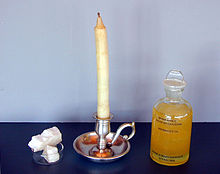
Spermaceti /spɜːməˈsiːti/ is a waxy substance found in the head cavities of the sperm whale (and, in smaller quantities, in the oils of other whales). Spermaceti is created in the spermaceti organ inside the whale's head. This organ may contain as much as 1,900 litres (500 US gal) of spermaceti.[1] It has been extracted by whalers since the 17th century for human use in cosmetics, textiles, and candles.
Theories for the spermaceti organ's biological function suggest that it may control buoyancy, act as a focusing apparatus for the whale's sense of echolocation, or possibly both. Concrete evidence supports both theories.[2] The buoyancy theory holds that the sperm whale is capable of heating the spermaceti, lowering its density and thus allowing the whale to float; for the whale to sink again, it must take water into its blowhole, which cools the spermaceti into a denser solid. This claim has been called into question by recent research that indicates a lack of biological structures to support this heat exchange, and the fact that the change in density is too small to be meaningful until the organ grows to a huge size.[3] Measurement of the proportion of wax esters retained by a harvested sperm whale accurately described the age and future life expectancy of a given individual. The level of wax esters in the spermaceti organ increases with the age of the whale: 38–51% in calves, 58–87% in adult females, and 71–94% in adult males.[4]
Spermaceti wax is extracted from sperm oil by crystallisation at 6 °C (43 °F), when treated by pressure and a chemical solution of caustic alkali. Spermaceti forms brilliant white crystals that are hard but oily to the touch, and are devoid of taste or smell, making it very useful as an ingredient in cosmetics, leatherworking, and lubricants. The substance was also used in making candles of a standard photometric value, in the dressing of fabrics, and as a pharmaceutical excipient, especially in cerates and ointments.
The whaling industry in the 17th and 18th centuries was developed to find, harvest, and refine the contents of the head of a sperm whale. The crews seeking spermaceti routinely left on three-year tours on several oceans. Cetaceous lamp oil was a commodity that created many maritime fortunes. Candlepower, a photometric unit defined in the United Kingdom Act of Parliament Metropolitan Gas Act 1860 and adopted at the International Electrotechnical Conference of 1883, was based on the light produced by a single, pure spermaceti candle.
- ^ Norris, K. S.; Harvey, G. W. (January 1972). "A Theory for the Function of the Spermaceti Organ of the Sperm Whale (Physeter Catodon L.)" (PDF). Nasa, Washington Animal Orientation and Navigation. 262: 397. Bibcode:1972NASSP.262..397N.
- ^ Clarke, Malcom (1978). "Buoyancy Control as a Function of the Spermaceti Organ in the Sperm Whale". Journal of the Marine Biological Association of the United Kingdom: 63–64. Retrieved 21 Apr 2024 – via Cambridge Core.
- ^ Whitehead, Hal (2003-08-15). Sperm Whales: Social Evolution in the Ocean. ISBN 9780226895185.
- ^ Cite error: The named reference
EncyclopediaMarineMammals1164was invoked but never defined (see the help page).